#rockshelter
Explore tagged Tumblr posts
Text
Mount Elgon and Eastern African Agriculture

By Image courtesy: NASA/JPL-Caltech - version here, Public Domain, https://commons.wikimedia.org/w/index.php?curid=1178211
Mount Elgon sits on the border of Uganda and Kenya and is an extinct shield volcano known to the Maasai as 'Ol Doinyo Ilgoon' (Breast Mountain). It has five major peaks, with the tallest, Wagagai, having a height of 4,321 meters and lying in Uganda making it the 17th highest in Africa. It has not errupted in at least 25 million years.

Source: https://www.ancient-origins.net/news-history-archaeology-history-ancient-traditions/earliest-plant-farming-east-africa-0021068
The Kakapel Rockshelter presented a nearly 9000 year record of plant and animal life in the region, making it a good place to study how people lived in the area over a long course of time and the layers have been carbon dated, allowing researchers to understand that picture over time. Prior to this recent study, it was known that there was some agriculture in the area by 1000 years ago, but how far back agriculture in the area goes was uncertain. It was broadly thought that people were pastoralists, following flocks and herds of cattle, goats, and sheep.

Source: https://www.ancient-origins.net/news-history-archaeology-history-ancient-traditions/earliest-plant-farming-east-africa-0021068
What the researchers found was that about the time the Bantu speaking people who tended to be farmers moved into the area, about 2500 years ago, joining the people who were thought to be only herders. This shows there was movement toward domesticating crops much earlier than previously thought and that there was a robust exchange of ideas. The first domesticated crops that in the area were cowpeas and sorghum with evidence of wild grasses and other plants being used as well. This demonstrated that the people of this area were able to adapt to what they could grow or gather. The researchers hope this and continuing research will also help with food security and environmental stability moving forward.
2 notes
·
View notes
Note

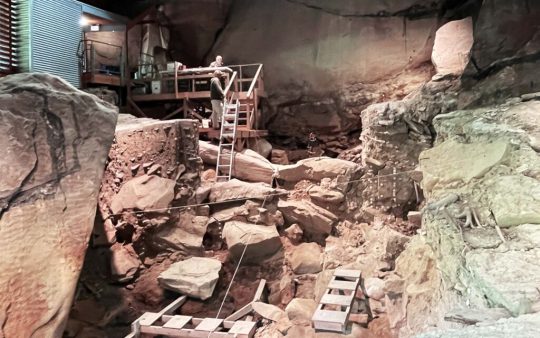
Meadowcroft Rockshelter and Historic Village, Pennsylvania, USA
30 notes
·
View notes
Text
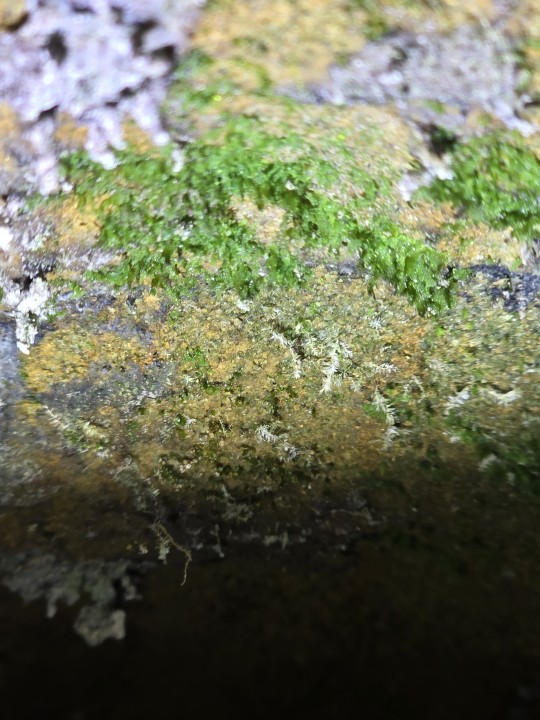





Under Council Chamber Rock many unique species thrive.
Got my light out for a few Sandstone rock shelter shots this time, Here is one of my favorite ferns:
Shoestring Gametophyte Fern, an Appalachian refugial species that exists only two rockshelter community types; in humid back dome and mild sandstone spraycliff communities within' deep shade.
Asexually surviving only in the gametophyte stage.
Vittaria appalachiana
35 notes
·
View notes
Note
Trick or treat! I’d love to hear about this asexual caveman project you speak of 👀
thank you!
So admittedly I am being kind of facetious calling them cavemen. The setting is 30,000 years ago in Eastern Europe or Western Asia. Gravettian culture era. And my group mostly doesn’t live in caves (Ice Age people didn’t often live in caves, at best they usually lived in shallow rockshelters, though many also resided in seasonal tents and huts.)
Atm I have my Paleolithic human group spending the winter in anachronistic but badass mammoth bone huts.
Shelters… made of mammoth bones! This was a real thing Ice Age people did!
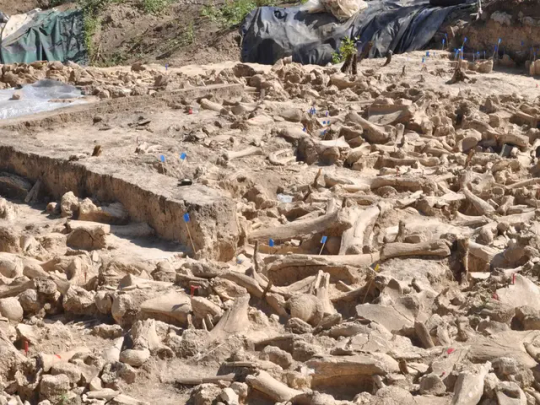
Image: an archaeological site strewn with the bones of at least 60 mammoths, which were used as the structural supports for tents or huts around 25,000 years ago. Western-ish Russia.

Image: hypothesized reconstruction of a mammoth bone hut from the site of Mezhyrich or Mezhirich, Ukraine, 15,000 years old. This shows exposed bone but it would likely have been covered in hides when it was in use.
My Ice Age protags live in mammoth bone huts in the winter because I think they’re rad. Honestly, one of my difficulties has been trying to decide on a time period setting, because I want Neanderthals (traditionally identified as going extinct 40,000 years ago, but some arguments for pockets of Neanderthals that survived up to 30,000 years ago, which I’m jumping on) but I also want mammoth bone huts (oldest known 25,000 years old, but more of them closer to 15,000 years old.) Mixing the last vestiges of surviving pockets of Neanderthals knowing they’re going extinct without really having a framework for that, and Gravettian Homo sapiens making mammoth bone huts a few thousand years early because they’re trendsetters like that. However, they’re also highly mobile, not living full-time in any location.
They do have a sacred cave for religious activities and initiations. That becomes important later. The sacred cave can also trans your gender if u want it to.
24 notes
·
View notes
Text

Petroglyph (rock carving) of a quadruped (possibly wolf) from Gullickson’s Glen in the Driftless Area of southwestern Wisconsin. Findings suggest that Native Americans were occupying the rockshelter as long as 2,000 years ago, although the petroglyphs probably do not date farther back than 800 years ago. Excavations at the site have uncovered remnants of Middle Woodland and Oneota occupancy.
Learn more about Gullickson’s Glen at: http://mvac.uwlax.edu/past-cultures/specific-sites/rock-art/#Gullickson
9 notes
·
View notes
Text

Tracklist:
Shudder Before The Beautiful • Weak Fantasy • Élan • Yours Is An Empty Hope • Our Decades In The Sun • My Walden • Endless Forms Most Beautiful • Edema Ruh • Alpenglow • The Eyes Of Sharbat Gula • The Greatest Show On Earth (i. Four Point Six, ii. Life, iii. The Toolmaker, iv. The Understanding, v. Sear-Worn Driftwood)
Spotify ♪ YouTube
Submitter's note included under the break due to length.
This album is the first album made with their current and third singer and first without their previous drummer who had to retire due to severe insomnia and is themed around science and reason to constrast the previous album about fantasy. The latter part of the album quotes passages from Charles Darwin and Richard Dawkins. One of their live shows even had Richard Dawkins as a guest and he read live for their insane 21 minute track 'The Greatest Show On Earth' which is a song about evolutionary history. The album is intended by the songwriter Toumas Holopainen to be listened to beginning to end like a movie. The band camped out in an isolated cabin to write this album. They also got a crab "Tanidromites nightwishorum" AND a prehistoric rockshelter (Alpenglow Rockshelter) named after them/their songs for this album.
The band: Nightwish is a Finnish symphonic metal band that started in 1996 that has had three different lead singers over its run, with the first (Tarja Turunen) parting ways with the band in a very public and emotionally fraught friend breakup in 2005 that to this day causes divisive fights in the fanbase about the decision between the really old fans and the newer ones. Their current lead singer and the one for this album is Floor Jensen, a classically trained dutch singer who joined in 2015 and has incredible range. They are one of the most successful Finnish bands. Their songs contain repeating themes of wonder at the natural world and wanting to return to innocence/childhood, but may broach a variety of topics.
Songs not on this album you might know them from: End of All Hope - Song used a lot in amvs on youtube. Wish I Had An Angel - biggest US hit single Amaranth - got very popular in Europe as a single Ghost Love Score - The live version with Floor instead of the album version with Anette (the second singer) is fairly popular on youtube. This is a song that most fans start with as its a good introduction to Nightwish's current style without being too isoteric. Interesting song notes: In 'Yours Is an Empty Hope' that is indeed Floor doing the super low death growls. Marco is the one singing clean. Yes really. Alpenglow is considered the "ultimate Nightwish song" by Holopainen.
The Greatest Show on Earth is the longest song this band has recorded to date, includes quotes by Dawkins and Darwin, and includes homages to music history with excerpts from Dies Irae, Minuet in G major, Toccata and Fugue in D minor, BWV 565 by Bach and Enter Sandman by Metallica. Holopainen considers this song their most ambitious song to date he says the song "is probably the culmination of everything that we've done together". Personal notes: AAAAUUHGHGHG This band makes me insane. They make a song an atmospheric experience. Most bands are not great live- they are better live. Somehow. They have incredible stage presence. This album is my favorite Nightwish album and probably my favorite album of all time.
#hyltta-polls#polls#artist: nightwish#language: english#decade: 2010s#Symphonic Metal#Power Metal#Celtic Folk Music
12 notes
·
View notes
Text
Trip report, part 2!
Kooser State Park, Fall 2024
On the Sunday, we went to Meadowcroft Rockshelter and Historic Village, which is west of Pittsburgh, so the driving took a little longer than I'd have liked, but it's about three hours closer from Kooser than it is from my house. And the day was drizzly with occasional forays into actual rain, so it's a good day for something like that, where there are both outdoor and indoor exhibits to look at.
What Meadowcroft is famous for is the rockshelter, which is one of the oldest sites of human occupation in the Americas, dated to about 19,000 years ago.
What's interesting about that, is that prior to finding this site and a few others, the prevailing understanding was that the Americas were first settled sometime around 12,000 years ago.
If you've ever learned anything about the peopling of the Americas, here's an image (from Wikipedia) that may ring a bell:

During the most recent ice age, when a significant amount of the earth's water was tied up in glaciers, there was what's usually called a "land bridge" between what is now Siberia, and what is now Alaska.
(Incidentally, the name "land bridge" conjures up an image of something fairly narrow, that the people would have known was a significant crossing, but it was actually up to 600 miles (1000 km) wide. It's a narrow strip of land in the same sense that it would be fair to say that Pennsylvania occupies the narrow strip of land between the Atlantic Ocean and the Appalachian mountains--looking at a world map, that's a fair way to describe it, but that isn't what it seems like to live there. And the quote-unquote land bridge existed for thousands of years, so for many generations of people, it would have simply been where they lived.)
But I digress. Anyway, at the time that Siberia and Alaska were connected, what is now Canada and the northern portion of the US were covered in a solid sheet of ice, up to 3 km thick in places. Nothing grew on it the glacier, and as a result few animals ventured onto it. There's really no plausible way that people could have crossed it--until the glaciers started to melt. Around the same time that the "land bridge" was disappearing, an "ice-free corridor" would have opened up, allowing people to start to move southward. (As with the bridge, the corridor would have been much wider than the name implies, and people would not necessarily have though of it as a corridor.)
So it's a bit of a puzzle how the people in Pennsylvania got there 19,000 years ago. Or how the people at a site of similar age in Chile got there. Or the handful of other sites that have been found. The best theory now is that they made their way down the western coast of North America, possibly using small boats to hop from one habitable beach area to the next. Of course, as the glaciers melted, the coastline changed, so any traces these people left would have been long destroyed--except that, apparently, some of them hung a left as soon as they got below the glaciers, and traveled the entire way across the continent to Pennsylvania, and some others kept going South the whole way to Chile.
So Meadowcroft is an active archeological site and also a tourist site.
I forgot to take any pictures of it. Wikicommons has some, and I bought some postcards:

This is from the back of the shelter/excavation, looking out toward the tourist observation platform. The rockshelter is a natural overhang that created a covered area; there are tons of them in Pennsylvania.
And here's the observation platform:
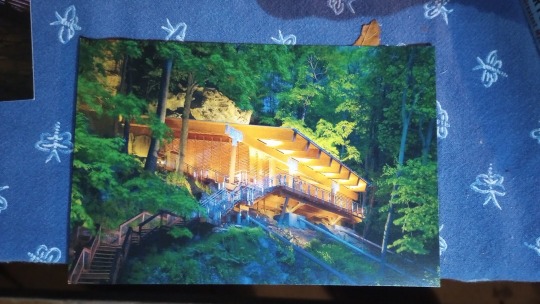
You have to take a shuttle bus from the visitor center to the rockshelter, and then climb those steps; this and the fact that the drive took me longer than I expected--meaning I didn't have a whole lot of time before they closed--is why I didn't go back and take pictures once I realized I'd forgotten to do any.
The shelter would have originally been about as big as the dig site plus the tourist platform, at the time of the first evidence of human occupation, but over the millennia the outer edge of the sandstone roof collapsed several times, due to erosion and weathering. The archeological evidence suggests it was mainly used in the fall--right about the time I was there--and probably by one or two families at a time. They know it was used mostly in the fall, because the plant food remains are things like walnuts, hickory nuts, and hackberries, that come in that time of year. They were also eating venison and turkey. The earliest signs of occupation are from 19,000 years ago, and the most recent (apart from the archaeologists themselves) were a campfire pit and a pile of beer cans from the 1970's.
Interestingly, when they excavated the 1970's fire pit, they found another one from the 1700's or 1800's under it.
Anyway! In addition to the rockshelter, they have some fairly conventional, but well-done, living-history type exhibits, and a small museum.
For some reason*, the small museum has one room devoted to harness-horse racing, and there was this neat little exhibit about a young woman who set a world trotting record in 1916. Here's the sign:

And what's left of her racing cart:
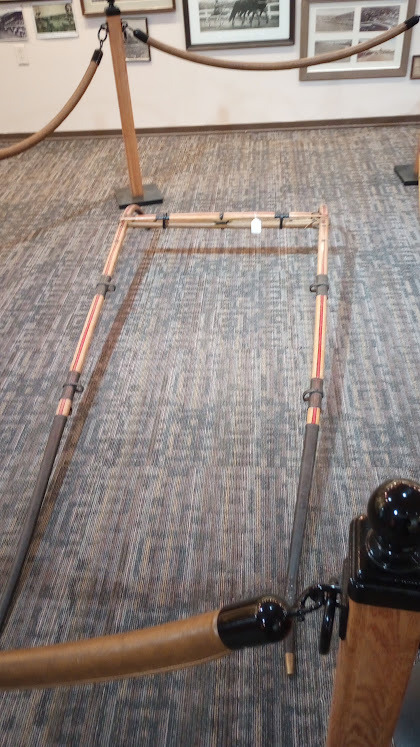
And some pictures of her driving her horse:

I can't imagine that there were many women competing in harness racing in the 1910's, so I thought that was pretty cool.
(*I think the reason is that the family that donated a bunch of stuff to the museum were active in the sport, but I didn't have enough time to read all the placards, so I'm not sure.)
Over in the 17th-century Frontier Village, they had a replica of a woodsman's shack, which you can see is very recognizable as a precursor of the Adirondack shelter:

The logs aren't chinked, and the roof is birch bark instead of brush, but this is very close to what Geralt and Julian's shelter would have looked like in The Witcher and the Lordling. (Theirs was bigger, of course.)
In real life, shelters like this would be built and used by men from the settler (European) community, who went out into the frontier to hunt; in this area they would have mainly been hunting deer, the hides of which were valuable for international trade.
I did not ask the interpreter why he has such a very noticeable gap between the top of his leggings and the bottom of his shirt. Broadly speaking, I believe the costume is historically accurate--@beboots might know more? But I think usually the leggings and shirt would overlap considerably, rather than...that.
But anyway! Here you can see the structure of the shelter a little better, with the two upright poles supporting the wall-poles:

And the lattice of poles supporting the roof:
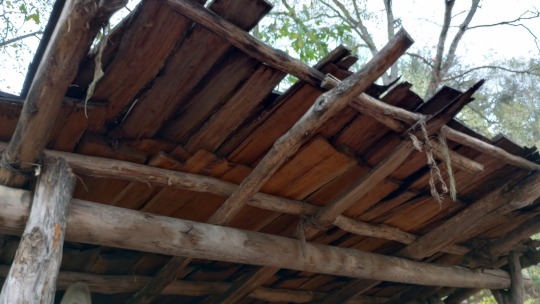
Forked branches holding up the roof-poles:

Some load-bearing pieces of twine:
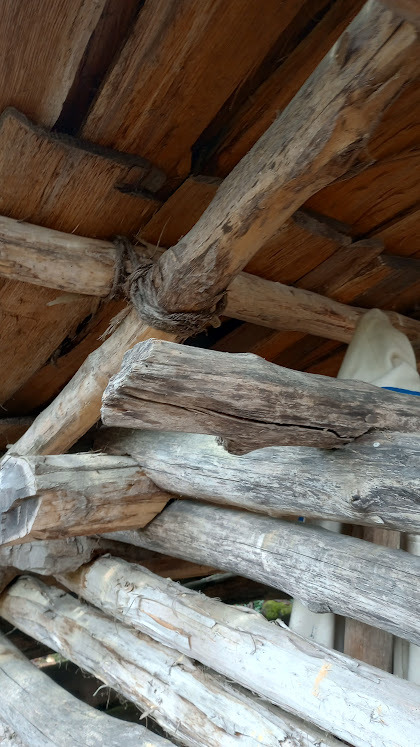
The Frontier Village also had a station where you could try your hand at axe-throwing:

The 16th-century Monongahela village had a fairly dilapidated brush hut:

This would have looked a lot better when the brush was still green; in Witcher and the Lordling, these are one of the types of huts Geralt would have sometimes built before the big winter hut. In real life, they were built when people were traveling away from the village for a few days.
Here's another temporary shelter from the Indian Village section:
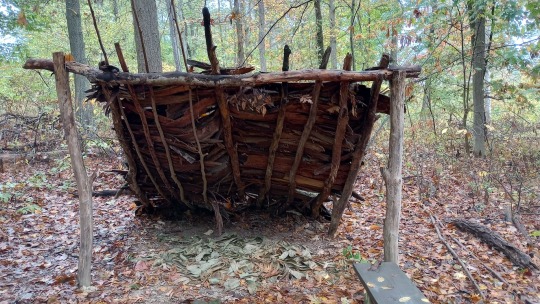
Again, in real life this would have been for short trips away from the village, for hunting or whatever other purposes.
In the village, the main dwellings were wigwams:

They only have one set up for you to go in, but they said that a real village would probably have had about five. They had a brush fence or palisade around the village, with their garden plots outside the fence, and a sort of pavilion, with a roof but no walls, that acted as the women's work area for processing plant foods and so forth.
Here's the lattice of poles that supports the wigwam:
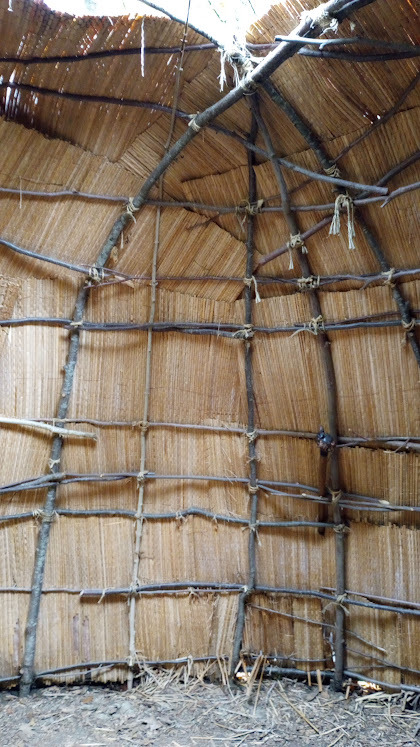
The real ones probably would have been sturdier; the interpreters said that when they make their replica structures they pretty much have to stick to using deadfall wood or any invasive species that are being cleared out; the actual pre-contact Monongahela would have had better materials as well as more expertise.
Here's the hearth:
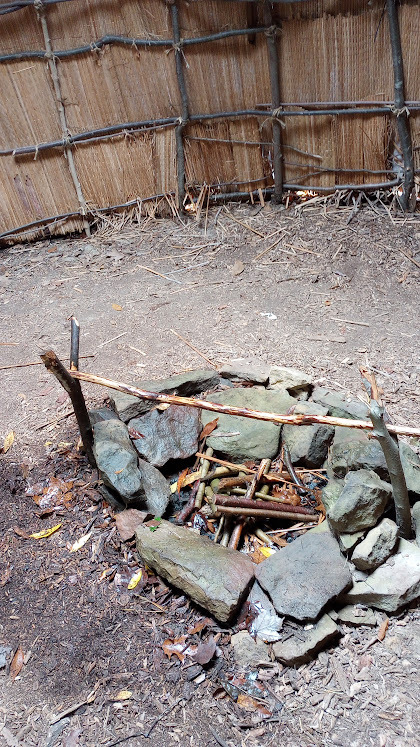
By this time period, chimneys existed in Europe, but a lot of non-wealthy people would have had basically the same arrangement, a central hearth in the main room.
The Monongahela village had another station where we could learn to throw an atlatl, which was very cool because I'd never quite understood how they worked.
About when I was doing that, I realized that I had very little time left before the place closed, so I raced through the 18th-century settler village without taking any pictures, dropped a hundred bucks at the gift shop, and went home, where my new rain canopy got a considerable workout as I cooked sausages in the rain.
It was really cool, though, and I want to go back--next summer, they're going to have some archaeologists digging a new section of the rockshelter and doing some lectures for the public, so I'd like to make it for that, and then also give myself enough time for a more thorough look at some of the exhibits that I raced through this time.
The next day, Monday, I made some further improvements to the shelter:

This was very necessary because it was raining harder, so quite a bit more was coming into the shelter, and also the two benches that I wanted to use as work surfaces for my cooking projects were at the edges, so anything I put on them got wet.
Project One was Campfire Brunch, consisting of hash browns (the dehydrated kind in a box), bacon, and eggs:

I cooked the bacon in the cast-iron skillet, and then put it in some foil to keep warm while I cooked the potatoes in the bacon fat. Yum!
Eggies:

All ready!

It came out pretty well--I usually just have oatmeal for breakfast on these trips, because I don't like getting up early, and then once I am up I want to get out hiking or whatever. But since it was raining too hard to do much of anything, and I had the canopy, it was a good time to try it.
I also tried making some cornbread--I used the little box of Jiffy mix that I picked up while I was buying the canopy--in my cast-iron kettle:

It didn't come out quite as well as this looks; the bottom was fairly burnt, but the top part tasted fine! And the burnt bits came out of the pot easily. One thing people sometimes do, when baking in this type of pot, is shovel some coals from the fire onto the pot lid; if I attempt this again, I'll probably try that.
I didn't take any pictures of supper, but it was a pottage of barley, rice, groats, and lentils, with herbs and dried mushrooms and stuff--I was aiming for a "what they eat in camp in a fantasy novel" kind of vibe, and it came out really well! Also some fish sauteed in butter in the skillet.
Definitely more elaborate campfire cooking than I've done before.
The next morning, we packed up and took a drizzly walk around Kooser lake before heading for home:

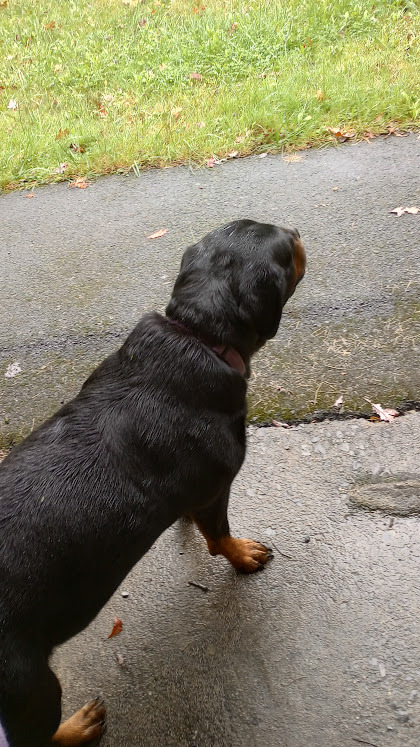
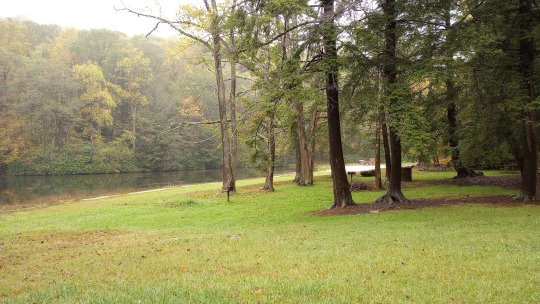
8 notes
·
View notes
Text

Ettore Mazza's rendering of a Neolithic pastoralist at Obishir rockshelter.
3 notes
·
View notes
Text


Source: Heinz History Center
Meadowcroft Rockshelter & Historic Village, near Avella, PA.
At 19,000 years old, this could be the oldest human settlement yet discovered in North America.
3 notes
·
View notes
Text
Humans in Tajikistan

Source: https://www.cambridge.org/core/journals/antiquity/article/soii-havzak-a-new-palaeolithic-sequence-in-zeravshan-valley-central-tajikistan/15641B5686DED6FF05D0D97EBB068AD3
It was long thought that the mountainous regions of Central Asia, with their cold, dry environment, would have been even less hospitable to hominids, especially during the last Glacial Maximum, when the climate was much colder than today.

Source: https://www.cambridge.org/core/journals/antiquity/article/soii-havzak-a-new-palaeolithic-sequence-in-zeravshan-valley-central-tajikistan/15641B5686DED6FF05D0D97EBB068AD3
It was, therefore, a surprise when remains from hominids living in the Soii Havzak area of the Zarafshan River Valley in Tajikistan during the Middle Paleolithic (from 150,000-20,000 years ago). A natural rockshelter carved into a cliff that is now about 40 meters above the surrounding ground level that preserved layers of sediment revealed well preserved bones, evidence of fire use, and stone tools. The preservation of the bones and that it was 1,000 meters above modern sea level might have given rise to an area that was relatively comfortable compared to less sheltered regions. The evidence of controlled fire point to the earliest inhabitants of the area being Neanderthal or Denisovans with humans coming later.

source: https://www.haaretz.com/archaeology/2024-11-04/ty-article-magazine/israeli-tajik-archaeologists-prove-early-human-presence-in-central-asia/00000192-f6c9-d9d0-a996-f7edbbdc0000
Researched selected the area because there was strong evidence of hominins in the Altai region and in the Levant, 3,000 kilometers away, but would have had a similar climate during the ice age as well as connected via valley systems. This has also led to a rethinking of the environmental conditions of Central Asia during the Middle Paleolithic, making the previously held beliefs shift about the climate of the area. This area, however, shows much reduced use during the Upper Paleolithic, when the weather globally was warmer and wetter.
6 notes
·
View notes
Text
Archaeologists find new evidence in Southern Oregon that suggests human habitation 18,000 years ago
#harneycounty#oregon#eastern oregon#the great pnw#the old west#oregonoutback#pnw#oregon outback#harney county#archeology#opb#oregon public broadcasting
25 notes
·
View notes
Text
The first published results from Juukan Gorge show 47,000 years of Aboriginal heritage was destroyed in mining blast
5 notes
·
View notes
Text
watching Stefan Milo's video about the Rimrock Draw Rockshelter, Oregon archaeological site dated to 18 THOUSAND YEARS OLD. holy shit. the first professor I had the pleasure of working with and taking her prehistory course my first semester of college was a pretty conservative paleoindian archaeologist working in Russia and Alaska and was really skeptical of any sites dated before 13kya so like that's the number I've had in my head. but the dating of this site is so firmly before 15kya (under a layer of volcanic ash, doesn't get too much better than that) and yea holy shit. the 18kya date is a tad more shaky imo bc that date was taken from a camel tooth found above it, so superpostition but not actually a date from the man-made tool or its layer. but either way super fucking cool
#im not the biggest archaeology girly#im a bone girl#but this is cool as fuck#enjoying stefan Milo's channel immensely#if you couldnt tell lol#archaeology#anthropology
2 notes
·
View notes
Text
Notre Dame, I think?
Unless you count the Meadowcroft Rockshelter, which is not a building in the sense of having been built, but was a structure used by humans as a dwelling.
7K notes
·
View notes
Text

Petroglyph (rock carving) of a deer from Gullickson’s Glenn in Jackson County, Wisconsin. Findings suggest that Native Americans were occupying the rockshelter as long as 2,000 years ago, although the petroglyphs probably do not date farther back than 800 years ago. Excavations at the site have uncovered remnants of Middle Woodland and Oneota occupancy.
28 notes
·
View notes
Text
Skhul and Qafzeh hominins
The Skhul and Qafzeh hominins or Qafzeh–Skhul early modern humans[1] are hominin fossils discovered in Es-Skhul and Qafzeh caves in Israel. They are today classified as Homo sapiens, among the earliest of their species in Eurasia. Skhul Cave is on the slopes of Mount Carmel; Qafzeh Cave is a rockshelter near Nazareth in Lower Galilee.
The remains found at Es Skhul, together with those found at the Nahal Me'arot Nature Reserve and Mugharet el-Zuttiyeh, were classified in 1939 by Arthur Keith and Theodore D. McCown as Palaeoanthropus palestinensis, a descendant of Homo heidelbergensis.[2][3][4]

The Skhul and Qafzeh remains in the context of late Homo taxa: Where do they fit in?

svdsmw
0 notes